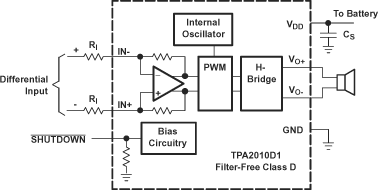SLOS417D October 2003 – November 2015 TPA2010D1
PRODUCTION DATA.
- 1 Features
- 2 Applications
- 3 Description
- 4 Device Comparison Table
- 5 Pin Configuration and Functions
- 6 Specifications
- 7 Parameter Measurement Information
- 8 Detailed Description
- 9 Application and Implementation
- 10Power Supply Recommendations
- 11Layout
- 12Device and Documentation Support
- 13Mechanical, Packaging, and Orderable Information
Package Options
Mechanical Data (Package|Pins)
- YZF|9
Thermal pad, mechanical data (Package|Pins)
Orderable Information
1 Features
- Maximum Battery Life and Minimum Heat
- Efficiency with an 8-Ω Speaker:
- 88% at 400 mW
- 80% at 100 mW
- 2.8-mA Quiescent Current
- 0.5-µA Shutdown Current
- Efficiency with an 8-Ω Speaker:
- Only Three External Components
- Optimized PWM Output Stage Eliminates LC Output Filter
- Internally Generated 250-kHz Switching Frequency Eliminates Capacitor and Resistor
- Improved PSRR (–75 dB) and Wide Supply Voltage (2.5 V to 5.5 V) Eliminates Need for a Voltage Regulator
- Fully Differential Design Reduces RF Rectification and Eliminates Bypass Capacitor
- Improved CMRR Eliminates Two Input Coupling Capacitors
- Die-size ball grid (DSBGA)
- NanoFree™ Lead-Free (YZF)
- NanoStar™ SnPb (YEF)
2 Applications
3 Description
The TPA2010D1 (sometimes referred to as TPA2010) is a 2.5-W high efficiency filter-free class-D audio power amplifier (class-D amp) in a 1,45 mm × 1,45 mm die-size ball grid array (DSBGA) that requires only three external components.
Features like 88% efficiency, –75-dB PSRR, improved RF-rectification immunity, and 8 mm2 total PCB area make the TPA2010D1 (TPA2010) class-D amp ideal for cellular handsets. A fast start-up time of 1 ms with minimal pop makes the TPA2010D1 (TPA2010) ideal for PDA applications.
In cellular handsets, the earpiece, speaker phone, and melody ringer can each be driven by the TPA2010D1. The TPA2010D1 allows independent gain while summing signals from separate sources and has a low 36 µV noise floor that is A-weighted.
Device Information(1)
| PART NUMBER | PACKAGE | BODY SIZE (NOM) |
|---|---|---|
| TPA2010D1 | DSBGA YEF (9) | 1.50 mm × 1.50 mm |
| DSBGA YZF (9) |
- For all available packages, see the Orderable Addendum at the end of the data sheet.
TPA2010D1 With Differential Input For A Wireless Phone

Revision History
Changes from C Revision (September 2007) to D Revision
- Added Pin Configuration and Functions section, Thermal Information table, ESD Ratings table, Feature Description section, Device Functional Modes, Application and Implementation section, Power Supply Recommendations section, Layout section, Device and Documentation Support section, and Mechanical, Packaging, and Orderable Information section Go